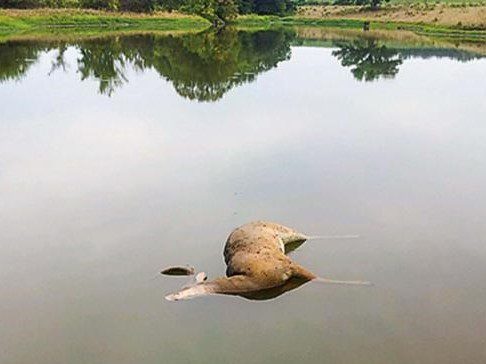
JEFFERSON CITY – The Missouri Department of Conservation (MDC) reports low levels of hemorrhagic disease (HD) in deer around the state. HD is a naturally occurring virus that infects deer through the bite of a native midge fly. It is common in Missouri between July and October when the insect that spreads it is most active.
Hemorrhagic disease in deer has been recently confirmed through diagnostic testing in Boone, Camden, Cole, Jackson, Linn, and Osage counties. MDC has received at least 100 reports of additional suspected cases from locations throughout the state.
“Hemorrhagic disease has been recognized in Missouri for many decades,” explained MDC Wildlife Health Program Supervisor Jasmine Batten. “We get reports of suspected cases every year and ask the public to report suspected cases of HD to their local MDC office or to email information to [email protected].”
Batten added that hemorrhagic disease can have severe impacts on localized deer numbers during some years with high infection rates, but transmission of the disease ends in the fall when heavy frost kills the midge flies. Deer populations are able to recover between outbreaks.
Hemorrhagic disease can be fatal to infected deer, but some deer survive and develop immunity.
“Clinical signs of hemorrhagic disease in deer vary but may include an unwillingness to move; difficulty breathing; and swelling of the head, neck, or tongue,” Batten explained. “Hemorrhagic disease can cause a high fever, prompting infected deer to seek out water sources. Deer that are sick may appear dazed, lethargic, and nonresponsive to the approach of people. Deer that die from hemorrhagic disease usually do so in a matter of days and are often found dead in or near water with no outward signs of illness.”
She added that HD is not directly contagious between infected deer and it is not known to infect people.
Learn more about hemorrhagic disease at huntfish.mdc.mo.gov/hunting-trapping/wildlife-diseases/hemorrhagic-disease. Report suspected cases of hemorrhagic disease to local MDC offices or email information to [email protected].
HD verses CWD
Batten noted that chronic wasting disease (CWD) is another disease found in Missouri deer that can show signs and symptoms similar to hemorrhagic disease (HD). MDC noted the following comparisons:
- HD symptoms include fever, reduced activity, and swollen neck, tongue, eyelids. Because sick deer are feverish, they are often found near or in water. Sick deer may appear dazed, lethargic, and nonresponsive to the approach of people.
CWD symptoms include excessive salivation, drooping head/ears, tremors, emaciation, and change in behavior such as lack of fear of humans and lack of coordination. - HD-infected deer typically show symptoms within days of being infected and those that die do so within weeks of being infected.
CWD can take more than 18 months for an infected deer to show symptoms. - HD does not kill all infected deer. Deer that survive develop antibodies for future immunity.
CWD kills all infected deer. - HD is caused by a naturally occurring virus spread by midge flies during the summer and fall and ends when cold weather kills the flies.
CWD is caused by misshapen proteins called “prions” and is spread through body fluids.
Learn more about CWD at mdc.mo.gov/cwd. Report suspected cases of CWD to local MDC offices or email information to [email protected].














